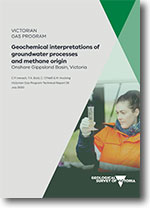VGP Technical Report 26 - Geochemical interpretations of groundwater processes and methane origin, Onshore Gippsland Basin, Victoria.
 |
| |||||||||||||||
Product description:About the Victorian Gas Program: The Victorian Gas Program (VGP) is a comprehensive science-led program, incorporating geoscientific and environmental research to assess the risks, benefits and impacts of potential onshore conventional gas exploration and production. The program is also investigating the potential for further discoveries of onshore conventional and offshore gas in the Otway and Gippsland geological basins and assessing the feasibility of additional onshore underground gas storage in depleted reservoirs around the Port Campbell area. The VGP includes an extensive, proactive and phased community and stakeholder engagement program, through which the results of the scientific studies are being communicated. Executive summary: A regional assessment of groundwater chemistry, environmental isotopes, dissolved gas and hydrocarbon occurrence has been conducted across the Gippsland Basin as part of the Victorian Gas Program (VGP). These baseline groundwater measurements were acquired from State Government groundwater bores using low-flow groundwater sampling techniques. This baseline study is the most complete groundwater chemistry dataset collected in the Gippsland Basin undertaken by the Victorian Government to date, building on existing data and providing a baseline measure of groundwater conditions. As part of the VGP environmental studies program, Geological Survey of Victoria (GSV) hydrogeologists have conducted baseline characterisation studies of the groundwater and atmosphere in the Gippsland Basin to determine current environmental conditions. This new groundwater chemistry dataset may support regulation of the sector by equipping government with a baseline it can use to monitor and report on any industry impacts. The groundwater sampling methods used are common to many groundwater geochemical studies conducted in Australia and internationally. In total, 22 samples were collected across the Gippsland Basin covering a depth range of 15 m to 1100 m with all samples analysed for 144 analytes. All samples were collected from groundwater bores that are part of the Victorian Government State Observation Bore Network (SOBN). Results from major ion chemistry show that the Gippsland Basin has generally good groundwater quality, with most samples being suitable for irrigation and stock use, and variable for drinking water use. Results also showed that evapotranspiration and groundwater mixing were the main controls on the groundwater chemistry. Stable water isotopes revealed a primarily meteoric origin of water in the Gippsland Basin, suggesting surface infiltration after rainfall is the main mechanism of recharge to the basin. Groundwater residence times in the basin did not display a significant trend with depth, with radiocarbon groundwater ages ranging from around 200 years to around 25 000 years. Methane (CH4) occurs naturally throughout the groundwater of the Gippsland Basin, generally increasing with depth. Additional data, such as the isotopic composition of the CH4 and its relationship with ethane (C2H6) suggest that most of the CH4 measured has been produced naturally by microbes in the groundwater. In some groundwater samples near the coast, additional data suggests that there may be a small natural gas component in the CH4. Longer-chain hydrocarbons and other petroleum by-products were detected in very small concentrations in most of the samples. Some of these can be attributed to sampler contamination, however there are two samples that suggest natural occurrence of these compounds. There were no significant differences between the duplicates that were collected on the same day and those that were collected two to three months after initial sampling. Comparison between results from this study and previous site-specific investigations yield comparable results, where any variations could be accounted by sampling method differences and laboratory variation. This report presents the chemical analysis of results and interpretations from groundwater samples collected in the onshore Gippsland Basin. It is intended to supplement the Gippsland Basin regional baseline technical report (Iverach et al., 2020a) and lend further context to results and interpretations presented within that report. Bibliographic reference: Iverach, C.P., Bold, T.A., O’Neill, C. & Hocking, M., 2020. Geochemical interpretations of groundwater processes and methane origin Onshore Gippsland Basin, Victoria Victorian Gas Program Technical Report 26. Geological Survey of Victoria. Download: The downloadable version of this report is supplied in PDF format (17.4 MB), accessible version (DOCX 8 MB) & Att A1 link. Related products:
| ||||||||||||||||


